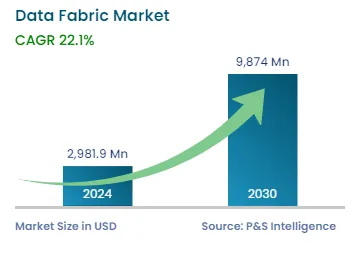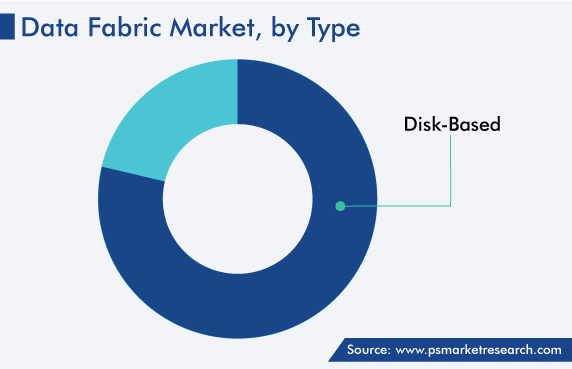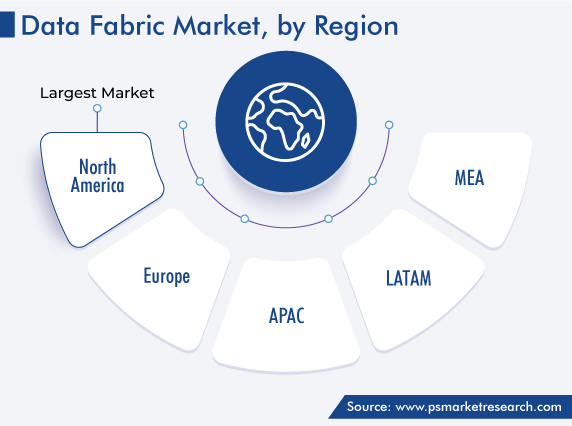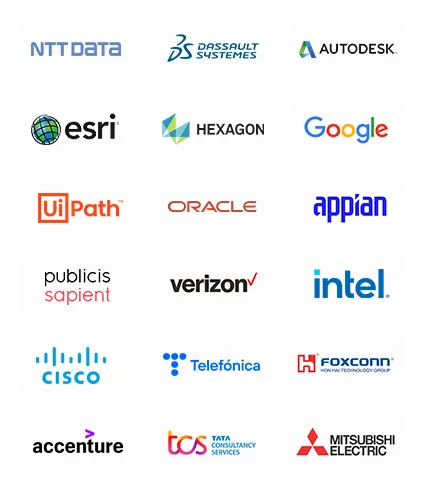Market Statistics
| Study Period | 2019 - 2030 |
| 2024 Market Size | USD 2,981.9 Million |
| 2030 Forecast | USD 9,874 Million |
| Growth Rate(CAGR) | 22.1% |
| Largest Region | North America |
| Fastest Growing Region | Asia-Pacific |
| Nature of the Market | Consolidated |
Report Code: 12576
Comprehensive Overview of the Data Fabric Market Report Prepared by P&S Intelligence, Segmented by Component (Solutions, Services), Type (Disk-Based, In-Memory), Organization Size (Large Enterprises, SMEs), Deployment Mode (On-Premises, Cloud), Applications (Fraud Detection & Security Management, Government, Risk & Compliance Management, Customer Intelligence, Sales & Marketing Management, Business Process Management, Preventative Maintenance Analysis), Verticals (BFSI, Government, Defense & Public Agencies, Manufacturing, Healthcare & Life Sciences, Energy & Mining, Telecom, Media & Entertainment, Retail & eCommerce), and Geographic Regions. This Report Provides Insights from 2019 to 2030
| Study Period | 2019 - 2030 |
| 2024 Market Size | USD 2,981.9 Million |
| 2030 Forecast | USD 9,874 Million |
| Growth Rate(CAGR) | 22.1% |
| Largest Region | North America |
| Fastest Growing Region | Asia-Pacific |
| Nature of the Market | Consolidated |

Explore the market potential with our data-driven report
The data fabric market size stood at USD 2,981.9 million in 2024, and it is expected to grow at a CAGR of 22.1% between 2024 and 2030, to reach USD 9,874 million by 2030.
Data generation has surged due to the rise of internet platforms and the digital revolution they are driving. The increasing internet usage and the rising number of connected devices, including smartphones, laptops, tablets, and PCs, have a direct impact on the volume and variety of corporate information generated in the electronic form. For instance, cameras and other kinds of sensors continuously gather location-related information for surveillance and analytical purposes, with businesses utilizing data analytics for their growth.
In the last few years, a high penetration of big data analytics has been observed among scholars and practitioners. Millions of dollars have been invested globally in this area by both the public and private sectors. The development and acceptance of technologies such as AI and the IoT, as well as the rapid rise in the volume and complexity of mobile traffic and the usage of cloud computing, are driving the demand for analytics tools. Many of the tasks involved in the exploration, preparation, and integration of data are projected to drive the need for a data fabric to power enterprises with extensive databases and related analytics.
The demand for such disk-based services and solutions globally is being driven by the need to store the enormous volume and variety of data in centralized repositories, to make its management and location easy.
Hence, with a share of more than 79% in 2022, the disk-based category led the type segment. This has been due to the growing need for data management across various repositories, as well as the lower costs associated with data compliance and ownership in this type of this fabric.
Moreover, the in-memory category will likely experience the higher CAGR, of around 26%, during forecast period.
In the coming years, the demand for low-latency data access, to support real-time predictive analytics, will cause the in-memory data fabric to expand quickly. It offers essential data storage facilities for various business applications and functions between applications and various sources. It offers in-memory computing components that can be used separately, while being properly integrated with one another.
Since in-memory databases store the information in hardware memory and may be used in the cloud or on-premises with commodity hardware ecosystems, they save time while processing the information. Seeing the growing demand for these systems, Oracle released Oracle Coherence version 14.1.1 in March 2020, which introduced vital new applications to the sector. Moreover, container and orchestration ecosystems, such as Kubernetes and Docker, are completely compatible with the platform.

During the projection period, the services category is set to have a significant growth. Market participants provide clients with a range of services as due to the demand for real-time connectivity, traditional data integration cannot satisfy the needs of today's enterprises. Despite the fact that many companies are capable of gathering data from diverse sources, they often struggle to integrate, process, curate, and transform it.
In 2022, the solution category held over 82% data fabric market share. The rise in the popularity of such platforms can be attributed to the surging need for improvement in business management. By reducing the obstacles created by data loss and enabling real-time streaming analytics, the architecture supports business agility.
With a revenue share of around 70% in 2022, the large enterprises category was dominant. Larger firms use a lot of digital information, the volume of which is continuously growing. Additionally, these firms frequently integrate and manage their information in different sets. Thus, there is a need for an architecture to maximize the management of the huge volumes of the data existing in data silos, with the introduction of numerous management technologies, including pipelining, governance, orchestration, and data catalogs.
Over the forecast period, the SMEs category is expected to expand significantly, as a result of the growing need of such firms for analytics and the optimization of the data. Management procedures are standardized by data fabric across on-premises, cloud, and edge devices. Additionally, promotional offerings, such as free trials, would accelerate the adoption of the data fabric architecture in small and medium-sized enterprises.
Drive strategic growth with comprehensive market analysis
North America dominates the market as it was the first to adopt the technology. Moreover, in the region, the U.S. held more than 85% share in 2022. Because of the rising use of databases in various BI tools and the increasing penetration of digital technologies in the BFSI, telecom & IT, healthcare, and manufacturing sectors, the usage of such solutions in the country is predicted to rise quickly throughout the projection period. Additionally, the economy of the U.S. is rather strong, and the country has seen significant investments in digital infrastructure of late.
Moreover, the region’s quickness in adopting new and innovative technologies is expected to present opportunities for vendors. This will essentially be due to the exponential growth in the amount of information generated by IT devices and the strict laws and regulations enacted in the region to protect it. The development in the market would further be aided by the investments in a number of technologies, including AI, IoT, and big data.
Moreover, the adoption of data management services is increasing in Europe as big data technologies advance at an exceedingly rapid rate. Daily, large sets of information are generated by social and economic activity, due to the increasing use of electronic devices and networks, advancements in information and communication technology, and the digitization of production processes. The U.K., Germany, France, Russia, Nordic countries, and Italy are some of the key countries in Europe with a significant penetration of such technologies.
Additionally, APAC is predicted to experience a significant growth rate, due to the rampant construction of data centers and a rapid transition toward digitalization. China is the second-largest country in the world behind the U.S. in terms of data center adoption. Therefore, as data center setup, IoT adoption, and innovations in analytics technologies pick up, the data fabric technology will receive deeper penetration around the globe.

Based on Component
Based on Type
Based on Organization Size
Based on Deployment Mode
Based on Applications
Based on Verticals
Geographical Analysis
The market for data fabric solutions was worth USD 2981.9 million in 2024.
The data fabric industry is driven by the booming generation of structured and unstructured digital data.
In 2030, the market for data fabric solutions will reach USD 9,874 million.
Service demand will increase faster in the data fabric industry.
North America is the largest contributor to the market for data fabric solutions.
Want a report tailored exactly to your business need?
Request CustomizationLeading companies across industries trust us to deliver data-driven insights and innovative solutions for their most critical decisions. From data-driven strategies to actionable insights, we empower the decision-makers who shape industries and define the future. From Fortune 500 companies to innovative startups, we are proud to partner with organisations that drive progress in their industries.


Working with P&S Intelligence and their team was an absolute pleasure – their awareness of timelines and commitment to value greatly contributed to our project's success. Eagerly anticipating future collaborations.
McKinsey & Company
IndiaOur insights into the minutest levels of the markets, including the latest trends and competitive landscape, give you all the answers you need to take your business to new heights
We take a cautious approach to protecting your personal and confidential information. Trust is the strongest bond that connects us and our clients, and trust we build by complying with all international and domestic data protection and privacy laws
Customize the Report to Align with Your Business Objectives
Request the Free Sample Pages